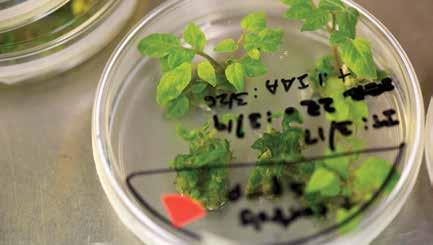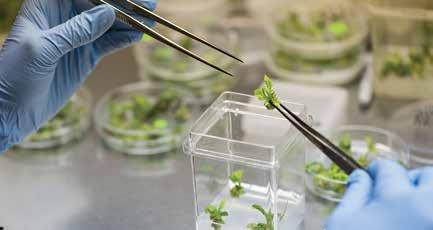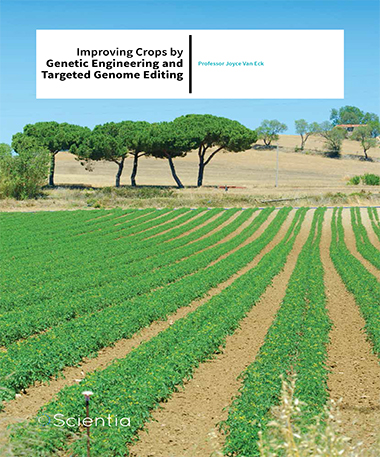Professor Joyce Van Eck – Improving Crops By Genetic Engineering And Targeted Genome Editing
Located at the Boyce Thompson Institute, an independent affiliate of Cornell University, the Van Eck lab explores novel methods for major crop improvement possibilities offered by a powerful gene editing method called CRISPR/Cas9.

Portrait of a bioengineer
Professor Joyce Van Eck was passionate about science from a very early age. Her interest in science spiked in elementary school, where she especially enjoyed performing experiments. During her secondary education, she was first acquainted with advanced biology and genetics, which she instantly became fascinated by. As she advanced through school, she considered specialising as a paediatrician with a focus on genetic counselling. However, in college she realised that the path to becoming a paediatrician was burdened with dissecting organisms during laboratory classes. To avoid the unpleasantness of this practice, she chose to reorient her studies toward other areas of expertise that combined her passion for genetics with different types of research. It was then that she realised the great potential of plant research, particularly that involving crop improvement and plant breeding. ‘I was totally amazed and imagined all the possibilities for helping to improve crops to resist disease and insects, plus other traits that could be of benefit to crop productivity.’ Professor Van Eck explains, ‘I was especially intrigued by how genetic engineering could be helpful when traits of interest like disease resistance were not already found in plant germplasm that could be exploited by plant breeders to incorporate into their crop improvement programs.’ Many of our crops do not have the necessary genetic traits for resisting disease, and therefore their survival must be aided by genetic engineering, a domain of great interest to Professor Van Eck.
Professor Van Eck went on to receive her PhD for a thesis on the ‘Transfer of large amounts of DNA via somatic hybridization and particle bombardment’. Having successfully completed her education and thesis research, Professor Van Eck used her expertise to teach students, advise industrial companies about how to develop new gene transfer methods, and create plant-made vaccines. In 2008, she became the Director of the Boyce Thompson Institute Centre for Plant Biotechnology Research, where she is also an Assistant Professor since 2013. The Boyce Thompson Institute is an independent affiliate of Cornell University. She leads a research lab with a focus on biotechnological approaches to the study of gene function and crop improvement. Throughout their research, the Van Eck lab applies several genetic engineering strategies to two major food crops, namely potato and tomato. ‘The focus of my work is to use biotechnological approaches to identify genes of interest that can help improve plants and to study the function of those genes.’ Professor Van Eck explains. ‘My group also develops new genetic engineering systems and improves existing systems to make them more efficient. Through our work we are able to determine the genes that would have the most impact on traits to help improve the productivity of crops.’ Amongst other methods, the team uses CRISPR/Cas9, a powerful genome editing tool inspired from the inner workings of bacteria. CRISPR is a genetic library that can rapidly perform massive gene alterations, and delete and insert new genes with the help of the Cas9 enzyme. In addition, the team is working on finding new approaches to enhance the nutritional quality of food crops, such as increasing the vitamin and mineral content. Aside from their own projects, Professor Van Eck and her team also support various other research groups in their discoveries. ‘We especially enjoy helping groups and knowing we played a role in their discoveries,’ she tells Scientia.
‘I was totally amazed and imagined all the possibilities for helping to improve crops to resist disease and insects, plus other traits that could be of benefit to crop productivity’

Threatened species conservation efforts
One of Professor Van Eck’s projects involved developing a method to help understand the potential extinction of an endangered plant species. This phenomenon often occurs due to new and threatening conditions arriving in the plant habitat, such as climate change, herbivores, and the invasion of competitive plants. Agrimonia rostellata, or beaked agrimony, is considered an endangered plant in New York State, as it remains in only 17 locations. The plant is a perennial herb living in central and eastern US, which grows in woods, rocky environments and on stream banks. Being on average about 60 centimeters tall, Agrimonia rostellata grows small yellow flowers and fruits. The reasons why it is vanishing are difficult to understand, because research requires taking seeds from the already small pool of remaining plants. To fully understand species decline, these studies need large populations which can be tracked over several years, so scientists must increase the number of plants in the lab if they are to conduct studies to understand and prevent extinction. Professor Van Eck’s lab developed an in-vitro method to do just that. The team worked with 15 plants obtained from three separate locations, from which they took nodes necessary for growing new plants. However, the greatest threat they encountered when propagating Agrimonia rostellata crops in the lab was the development of a fungal infection. A major challenge was to find an approach to remove the fungus that did not have a negative effect on plant growth, and worked on the fungal WWW.SCIENTIAPUBLICATIONS.COM spores as well. The nodes were kept separate from each other in test tubes and rinsed in several anti-fungal solutions, and were then prepared for plantation once new plants developed from the nodes. This threatened plant species conservation and propagation effort is just one example of the capabilities of plant science. As the climate continues to change and more species become threatened, similar efforts are necessary to protect and recover the diversity of our flora.
 Testing CRISPR/Cas9 on tomatoes
Testing CRISPR/Cas9 on tomatoes
Ever since it was first reported in 2013, CRISPR/Cas9 has become the tool of choice for geneticists who edit plant genomes. CRISPR stands for Clustered Regularly Interspaced Short Palindromic Repeats, which are segments of prokaryotic DNA composed of short repetitions of DNA base sequences. These sequences are separated by a piece of spacer DNA, with an isolating role and no encoding properties. Cas9 is an endonuclease – an enzyme that cuts DNA strings into pieces – and has the ability to recognise specific DNA sequences, which helps to guide it to where to make the cuts. When it first appeared, the CRISPR gene editing tool was only used on human and bacterial DNA. Professor Van Eck and her colleagues were the first to test if this technique could be successfully applied to the tomato plant. At the time of the research, the tool had already been used on wheat, rice and sorghum, but it was unknown whether its applicability would extend to any type of plant. Moreover, it was not clear whether the genetic modifications would always propagate to the next generation of plants, or if it this was only limited to the stable transgenic lines. In order to test whether CRISPR worked for tomatoes, the researchers chose to delete a portion of a gene whose interrupted function produces wiry, needle-like leaves early in the process of plant growth, such that the mutation is immediately recognisable. The research led to the successful modification of the recovered plants. Most modified plants presented the expected results; however, one of the plants interestingly exhibited genomic deletions in an unintended region upstream from the targeted part of the DNA chain, and another three presented unexpected gene deletions as well. Following the first part of the experiment, the researchers proceeded to test whether the modifications are passed onto new generations. Because they knew the modified plants will have low fertility, they tested for heritability by using their pollen to fertilise flowers of other wild- type tomato plants. The low fertility only yielded four new plants, but they were all tested and confirmed positive for deletion. Overall, the findings confirmed the excellent potential of using CRISPS/Cas9 in the genome editing of tomatoes. The complete description of the research can be found in a paper on ‘Efficient Gene Editing in Tomato in the First Generation Using the Clustered Regularly Interspaced Short Palindromic Repeats/ CRISPR-Associated9 System’.
‘The focus of my work is to use biotechnological approaches to identify genes of interest that can help improve plants and to study the function of those genes’

Photograph courtesy of Sheryl Sinkow
Research models and future works
Tomatoes are used very often as models in plant biotechnology research because they are a vastly important crop for the worldwide economy and because of the availability of many resources including a high quality genome sequence and mutant ‘The focus of my work is to use biotechnological approaches to identify genes of interest that can help improve plants and to study the function of those genes’ species. Therefore, Professor Van Eck’s team investigated an approach to improve the genetic engineering methodology and the results are reported in a paper titled ‘Modification of plant regeneration medium decreases the time for recovery of Solanum lycopersicum cultivar M82 stable transgenic lines’. A cultivar is a plant variety resulting from cultivation by selective breeding, whereas transgenic lines can be understood as gene implants where researchers use microbes or other methods to transfer genes into the target organism. In this way, tomatoes can gain immunity to viral or bacterial infections. Therefore, it is important to have reliable and efficient methods with a high probability of gene transfer success. The paper studied gene transfer methods for tomatoes and explored whether the transgenic lines can be recovered faster when aided by components of the medium in which the crop was grown. During this research, Professor Van Eck and her team found a growth medium that reduced the time necessary to recover transgenic lines by six weeks in comparison with the regular medium used in such experiments. Moreover, the new medium had no negative results on the cultures. In this experiment, they used Agrobacterium to mediate the gene transfer.

Photograph courtesy of Sheryl Sinkow
When asked about her future research plans, Professor Van Eck explains: ‘The next steps for my research are to develop approaches to elucidate the key steps and genes of the domestication process. In other words, identify the functions of genes responsible for transforming wild species or progenitors into the food crops we know now. A potential outcome of this work is determining biotechnological approaches to developing plant species not commonly used as food crops because of unmanageable growth, small fruits, or low yield and having them become attractive for growers and farmers. In addition, I will continue to exploit genome editing as a tool to study gene function and make targeted changes at gene level to improve plants. We have found CRISPR/Cas9 to be a powerful tool to identify the genes and gene networks involved in plant stem cell proliferation, flowering, and branching in tomato. Tomato serves as a model crop for our work, but our intent is to use what we learn in tomatoes and apply it to other plant species.’
Meet the researcher

Professor Joyce Van Eck
Assistant Professor
Boyce Thompson Institute
Director, BTI Center for Plant Biotechnology Research
Professor Joyce Van Eck is an Assistant Professor at the Boyce Thompson Institute (BTI) and the Director of the BTI Center for Plant Biotechnology Research. She leads a research lab with a focus on biotechnological approaches to the study of gene function and crop improvement. For this research, the Van Eck lab applies several genetic engineering strategies to two major food crops: potatoes and tomatoes. Over the course of her career, Professor Van Eck has been presented with many awards, such as the US Secretary of Agriculture’s Honor Award for increasing global food security and Dow AgroSciences’ Above and Beyond Award.
CONTACT
W: http://bti.cornell.edu/staff/dr-joyce-van-eck/
T: (+1) 607 2541686
KEY COLLABORATORS
Tom Brutnell, The Danforth Plant Science Center, St. Louis, Missouri
Zach Lippman, Cold Spring Harbor Laboratory, Cold Spring Harbor, New York
Michael Schatz, Johns Hopkins University, Baltimore, Maryland
FUNDING
NSF
REFERENCES
F Altpeter, NM Springer, LE Bartley, AE Blechl, TP Brutnell, V Citovsky, LJ Conrad, SB Gelvin, DP Jackson, AP Kausch, PG Lemaux, JI Medford, ML Orozco-Cárdenas, DM Tricoli, J Van Eck, DF Voytas, V Walbot, K Wang, ZJ Zhang and CN Stewart, Jr, Advancing Crop Transformation in the Era of Genome Editing, Plant Cell, 2016, DOI:10.1105/tpc.16.00196. Genome Editing, Plant Cell, 2016, 28, 1510.
C Xu, KL Liberatore, CA MacAlister, Z Huang, Y-H Chu, K Jiang, C Brooks, M Ogawa-Ohnishi, G Xiong, M Pauly, J Van Eck, Y Matsubayashi, E van der Knaap and ZB Lippman, A cascade of arabinosyltransferases controls shoot meristem size in tomato, Nature Genetics, 2015, 47, 784.
J Van Eck, P Keen and V Nuzzo, Development of an in vitro propagation method for the classified New York State–threatened native species Agrimonia rostellata, Native Plants, 2015, 16, 227.
C Brooks, V Nekrasov, ZB Lippman and J Van Eck, Efficient Gene Editing in Tomato in the First Generation Using the Clustered Regularly Interspaced Short Palindromic Repeats/ CRISPR-Associated9 System, Plant Physiology, 2014, 166, 1292–1297.


